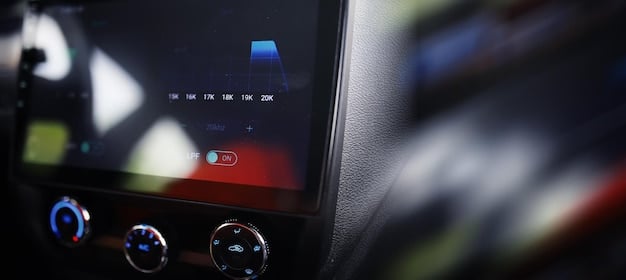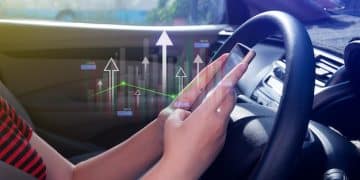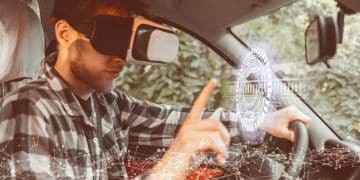5G’s Game-Changing Impact on Connected Car Services

The Impact of 5G on Connected Car Services: Faster Speeds, New Possibilities brings transformative changes by offering higher data transmission rates, lower latency, and increased network capacity, enabling advanced features such as real-time navigation, enhanced safety systems, and immersive in-car entertainment experiences.
The advent of 5G technology promises to redefine the capabilities and user experience of connected car services. The Impact of 5G on Connected Car Services: Faster Speeds, New Possibilities is poised to revolutionize everything from navigation to infotainment, and even safety features, creating a more seamless and responsive driving environment.
Understanding 5G and Its Benefits for Automotive Connectivity
5G, the fifth generation of wireless technology, is more than just a faster internet connection for smartphones. In the automotive world, it represents a monumental leap forward in terms of connectivity speed, reliability, and capacity compared to its predecessor, 4G.
The enhanced capabilities of 5G unlock new possibilities for connected car services, which were previously limited by the constraints of older network technologies.
Faster Data Transmission
One of the key advantages of 5G is its significantly faster data transmission rates. This means connected cars can send and receive data much more quickly, allowing for real-time updates and interactions. The increased speed enables a host of new features.
Reduced Latency
Latency, or the delay in data transfer, is drastically reduced with 5G. This is crucial for applications that require instantaneous responses, such as autonomous driving systems and advanced safety features, where split-second decisions can make a difference.

Here are the main benefits of reduced latency:
- Enables real-time communication between vehicles and infrastructure.
- Supports safer and more responsive autonomous driving capabilities.
- Improves reaction times for safety-critical systems.
In conclusion, 5G’s core benefits—faster data transmission and reduced latency—are foundational to the advancement of connected car services, paving the way for innovations that enhance safety, convenience, and the overall driving experience.
Enhanced Navigation and Real-Time Traffic Updates
Navigation is no longer just about getting from point A to point B. With 5G, navigation systems in connected cars can provide real-time traffic updates, dynamic rerouting, and even predictive analysis to anticipate potential road hazards. This level of sophistication makes the driving experience safer and more efficient.
5G-enabled navigation is a game-changer for drivers in urban and rural settings alike.
Real-Time Traffic Information
5G allows navigation systems to gather and process real-time traffic data from a variety of sources, including other connected vehicles, traffic cameras, and infrastructure sensors. This data is then used to provide drivers with up-to-the-minute information about traffic conditions, enabling them to make informed decisions about their routes.
Dynamic Rerouting
Based on real-time traffic information, 5G navigation systems can dynamically reroute drivers to avoid congestion, accidents, and road closures. This helps drivers save time, reduce stress, and minimize fuel consumption.
Here some advantages of dynamic routing:
- Reduces overall commute times.
- Minimizes exposure to traffic congestion.
- Improves fuel efficiency and reduces emissions.
In essence, 5G-enhanced navigation systems offer a more proactive and adaptive approach to driving, ensuring drivers arrive at their destinations safely and efficiently by leveraging real-time data and predictive analytics.
Revolutionizing In-Car Infotainment and Entertainment
In-car entertainment is getting a major upgrade, thanks to 5G. Imagine streaming high-definition video without buffering, engaging in immersive virtual reality experiences, or participating in multiplayer gaming sessions while on the road. 5G’s high bandwidth and low latency make all of this possible.
This revolution is transforming the car into a mobile entertainment hub.
High-Definition Streaming
With 5G, passengers can stream high-definition video content from services like Netflix, Hulu, and Disney+ without experiencing buffering or interruptions. This is particularly appealing for long trips, where passengers can stay entertained throughout the journey.
Virtual Reality (VR) Experiences
5G’s low latency and high bandwidth can also enable immersive virtual reality experiences inside the car. Passengers can use VR headsets to explore virtual worlds, play interactive games, or even participate in virtual meetings while on the road.

Here the main use cases of in-car VR:
- Interactive and engaging entertainment for passengers.
- Educational and informative experiences.
- VR-based gaming and social interactions.
In addition to enhancing entertainment, 5G’s infotainment capabilities also offer practical benefits, such as over-the-air software updates, seamless integration with smart home devices, and access to cloud-based services. Ultimately, 5G is turning the car into a personalized and connected mobile living space.
Enhancing Vehicle Safety with Advanced Connectivity
Safety is paramount in the automotive industry, and 5G is poised to play a critical role in enhancing vehicle safety features. With its low latency and high reliability, 5G enables advanced safety systems such as cooperative adaptive cruise control, collision avoidance systems, and remote vehicle control.
These technologies can significantly reduce the risk of accidents and improve overall road safety.
Cooperative Adaptive Cruise Control
Cooperative adaptive cruise control (CACC) uses 5G to enable vehicles to communicate with each other and maintain safe following distances. This helps to reduce traffic congestion, improve fuel efficiency, and prevent accidents caused by sudden braking.
Collision Avoidance Systems
Collision avoidance systems use 5G to gather and process real-time data from sensors, cameras, and other vehicles to detect potential hazards. This helps to prevent collisions by automatically braking or steering the vehicle away from danger.
Here the key safety benefits of 5G connectivity:
- Reduces the risk of accidents caused by human error.
- Improves reaction times in emergency situations.
- Enables advanced safety features that were previously impossible.
In conclusion, 5G’s advanced connectivity features are transforming vehicle safety, enabling a new generation of safety systems that can significantly reduce the risk of accidents and protect both drivers and pedestrians.
The Role of 5G in Autonomous Driving Development
Autonomous driving is perhaps the most ambitious application of connected car technology, and 5G is a crucial enabler of this vision. 5G’s high bandwidth, low latency, and reliable connectivity are essential for autonomous vehicles to gather, process, and act on the vast amounts of data required for safe and efficient navigation.
5G makes true autonomous driving a realistic prospect.
Real-Time Data Processing
Autonomous vehicles rely on a constant stream of data from sensors, cameras, and other sources to perceive their surroundings. 5G’s high bandwidth allows these vehicles to process this data in real time, enabling them to make quick and accurate decisions.
Vehicle-to-Everything (V2X) Communication
5G enables vehicles to communicate with everything around them, including other vehicles (V2V), infrastructure (V2I), pedestrians (V2P), and the cloud (V2C). This V2X communication is essential for autonomous vehicles to coordinate their movements, avoid collisions, and optimize traffic flow.
Major impacts of 5G on autonomous driving:
- Enables real-time decision-making based on comprehensive data.
- Facilitates seamless communication between vehicles and their environment.
- Supports safer and more efficient autonomous driving capabilities.
To summarize, 5G’s role in autonomous driving development is pivotal, providing the necessary connectivity and data processing capabilities that are essential for safe, efficient, and reliable autonomous transportation.
Challenges and Future Outlook for 5G Connected Car Services
While 5G promises a wealth of benefits for connected car services, there are also challenges that must be addressed to ensure its widespread adoption. These challenges include network coverage limitations, security concerns, and regulatory hurdles.
Overcoming these challenges is crucial for realizing the full potential of 5G in the automotive industry.
Network Coverage Limitations
5G network coverage is not yet ubiquitous, particularly in rural areas and underserved communities. This means that connected car services that rely on 5G may not be available in all locations. Expanding 5G network coverage is essential for ensuring that all drivers can benefit from this technology.
Security Concerns
As connected cars become more reliant on 5G, they also become more vulnerable to cyberattacks. Hackers could potentially exploit vulnerabilities in the 5G network to gain control of vehicles, steal data, or disrupt services. Robust security measures and protocols are necessary to protect connected cars from these threats.
These are the main changes for the future:
- Addressing network coverage gaps to ensure widespread availability.
- Implementing robust security measures to protect against cyber threats.
- Navigating regulatory hurdles to enable innovation and deployment.
In conclusion, while significant challenges remain, the future outlook for 5G connected car services is bright. As network coverage expands, security measures improve, and regulatory frameworks evolve, 5G is poised to transform the automotive industry and revolutionize the driving experience.
| Key Point | Brief Description |
|---|---|
| 🚀 Faster Speeds | Enhances real-time data processing and communication. |
| 🚦 Improved Navigation | Provides real-time traffic updates and dynamic rerouting. |
| 🎮 In-Car Entertainment | Enables high-definition streaming and virtual reality experiences. |
| 🛡️ Enhanced Safety | Improves collision avoidance and cooperative cruise control. |
Frequently Asked Questions
5G enhances connected car services by providing faster speeds, lower latency, and increased network capacity. This enables real-time data processing, improved navigation, enhanced entertainment, and advanced safety features.
5G enables real-time traffic updates, dynamic rerouting, and predictive analysis in navigation systems. This helps drivers avoid congestion, save time, and improve fuel efficiency.
5G allows for high-definition video streaming without buffering, immersive virtual reality experiences, and multiplayer gaming sessions. It transforms the car into a mobile entertainment hub.
5G improves safety features such as cooperative adaptive cruise control, collision avoidance systems, and remote vehicle control. These technologies reduce accidents and enhance road safety.
Challenges include network coverage limitations, security concerns, and regulatory hurdles. Addressing these issues is crucial for the widespread adoption and full potential of 5G in the automotive industry.
Conclusion
The Impact of 5G on Connected Car Services: Faster Speeds, New Possibilities is transformative, promising advancements in safety, entertainment, and autonomous driving. Overcoming existing challenges will pave the way for a fully connected driving experience.





